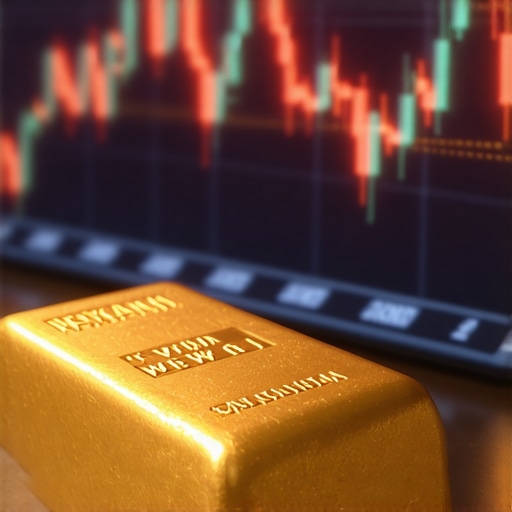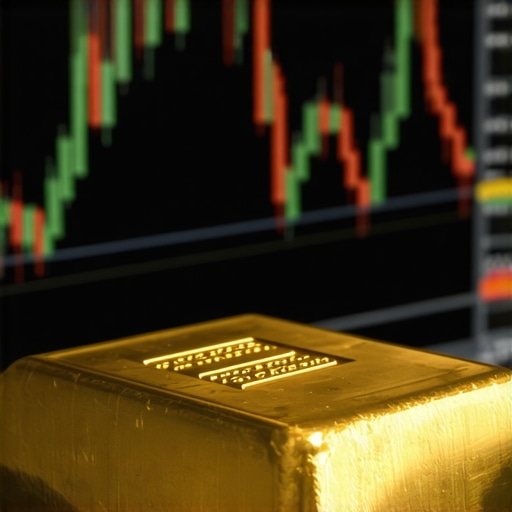Unveiling the Intricacies of Gold Price Dynamics in 2025: An Expert Analysis
As we approach 2025, understanding the multifaceted factors influencing gold prices becomes paramount for investors, policymakers, and industry stakeholders. Gold, long regarded as a safe haven and a barometer of economic stability, reacts to a tapestry of economic indicators and political developments. In this analysis, we delve into the core drivers shaping the gold market in 2025, rooted in advanced economic theories and geopolitical assessments.
Economic Foundations Shaping Gold Valuation in 2025
How Will Supply and Demand Shifts Affect Gold Prices?
The fundamental economic principle of supply and demand remains central to gold price fluctuations. In 2025, factors such as increased mining output, technological innovations in extraction, and alterations in recycling rates could influence supply levels. Concurrently, demand from sectors like technology, jewelry, and central banks plays a pivotal role. Notably, emerging markets’ growth and consumer investment behaviors are expected to exert upward pressure on demand, potentially elevating prices. For a comprehensive analysis, see this detailed supply-demand exploration.
Additionally, the dynamics of gold ETFs and futures trading serve as liquidity indicators, impacting short-term price movements. Understanding these nuances is essential for designing resilient investment strategies in 2025.
Political Climate and Its Influence on Gold Prices
In What Ways Do Geopolitical Tensions and Policy Shifts Impact Gold?
Political stability, international conflicts, and policy decisions significantly influence gold valuation. Heightened geopolitical tensions, such as conflicts in strategic regions or trade disputes, often lead to increased gold buying as a safe haven. Furthermore, central bank policies, especially regarding gold reserves and monetary expansion, can induce substantial price shifts. Recent trends show that central banks’ gold purchases, driven by diversification strategies amidst currency volatility, are a critical factor. For an in-depth understanding, review this analysis of central bank activities.
Moreover, political uncertainty within major economies, such as the US or China, can catalyze investor flight to gold, reinforcing its role as a hedge against systemic risks.
Expert Inquiry: What Are the Emerging Trends in Gold Demand and Supply for 2025?
Investors and analysts are increasingly scrutinizing industry-specific factors, including technological advancements in mining, regulatory shifts, and evolving consumer preferences. The interplay between industry supply chains and global economic health could reveal surprising developments. For a comprehensive perspective, explore this industry-focused analysis.
Engaging with these insights enables professionals to anticipate potential price trajectories and adapt investment portfolios accordingly.
Conclusion and Call to Action
In the volatile landscape of 2025, mastering the complex drivers of gold prices necessitates a nuanced understanding of economic fundamentals and geopolitical currents. Staying informed through expert analyses and market intelligence is crucial for making strategic decisions. For those committed to deepening their expertise, I invite you to explore our comprehensive guide to gold market analysis and contribute your insights within the professional community.
Unlocking the Future of Gold: How Industry Innovations and Policy Shifts Will Shape 2025
As we venture further into 2025, the landscape of gold pricing is evolving with unprecedented complexity. Innovations in mining technology and sustainable extraction practices are poised to influence supply levels significantly. For instance, breakthroughs in automation and environmentally friendly mining methods could reduce costs and increase output, potentially moderating prices. Conversely, regulatory changes in key jurisdictions might restrict supply, creating upward pressure. To understand these dynamics comprehensively, investors should explore this detailed industry analysis.
Moreover, political and economic policies are altering the traditional supply chain. Countries adopting stricter environmental standards or nationalizing resources could limit supply, making gold scarcer and more valuable. The balance between technological advancements and regulatory constraints will be crucial for predicting supply-side movements.
Can Gold Maintain Its Safe-Haven Status Amid Growing Economic Uncertainty?
This question challenges investors to reconsider the traditional narrative of gold as a refuge during turmoil. With global economies facing inflationary pressures, currency devaluations, and geopolitical tensions, gold’s role as a hedge remains vital. However, some experts argue that increased institutional investment in alternative assets, like cryptocurrencies or green bonds, might diversify the risk profile further. For a nuanced understanding, refer to this comprehensive guide on gold as a hedge.
Engaging with these insights allows investors to craft resilient strategies that leverage gold’s unique properties while accounting for emerging asset classes.
Harnessing Advanced Analytical Tools for 2025 Market Predictions
In an era characterized by rapid data proliferation, sophisticated analytical frameworks are vital. Techniques such as machine learning models and sentiment analysis can identify subtle market signals, providing a competitive edge. For example, predictive analytics that integrate macroeconomic indicators, geopolitical news, and supply-demand metrics enable more precise forecasting of gold prices. To develop a robust analytical approach, consider exploring this guide on market analysis tools.
Furthermore, integrating real-time data feeds and historical trends into decision-making processes enhances responsiveness to market shifts. These tools empower investors to implement dynamic strategies, optimizing entry and exit points in volatile environments.
What Strategic Frameworks Can Maximize Gold Investment Returns in 2025?
Adopting structured investment frameworks, such as risk-adjusted portfolio allocation and scenario planning, can significantly improve outcomes. Diversification across physical gold, ETFs, and mining stocks ensures exposure to different drivers of value. Additionally, setting predefined triggers based on technical indicators or macroeconomic shifts helps in timing trades effectively. For practical guidance, review this resource on smart investment strategies.
By combining these frameworks with continuous market monitoring, investors can adapt swiftly to unforeseen developments, safeguarding and growing their wealth in 2025.
To deepen your understanding of gold market nuances, I encourage you to share your insights or ask questions in the comments. Also, consider exploring top gold investment options for 2025 to diversify your portfolio effectively.
Leveraging Geopolitical Shifts and Economic Indicators for Precise Gold Market Forecasts in 2025
As global geopolitical landscapes evolve with increasing complexity, investors must refine their analytical frameworks to interpret the nuanced signals influencing gold prices. Recent research from the International Monetary Fund (IMF) emphasizes that geopolitical tensions—such as regional conflicts, trade disputes, and strategic alliances—can induce volatility in gold markets, often triggering rapid safe-haven demand surges (IMF Working Paper on Geopolitical Impact). To navigate these complexities, integrating advanced econometric models with real-time geopolitical risk assessments becomes crucial, enabling investors to anticipate sudden market shifts effectively.
Can Machine Learning Models Outperform Traditional Forecasting in Gold Price Predictions?
Emerging AI-driven tools have demonstrated promising capabilities in capturing nonlinear market behaviors and sentiment-driven fluctuations. Techniques such as neural networks, ensemble learning, and natural language processing (NLP) for analyzing news sentiment provide a granular understanding of market drivers. According to a 2024 study published in the Journal of Financial Data Science, machine learning models incorporating macroeconomic variables and geopolitical event data achieved a 15% improvement in predictive accuracy over conventional econometric models (JFDS Study on AI in Market Forecasting). Investors should consider deploying these tools within a comprehensive risk management framework to enhance decision-making precision in 2025.

Strategic Diversification: Balancing Physical Gold, ETFs, and Mining Stocks for Resilient Portfolios
Optimal diversification strategies involve a nuanced understanding of each asset class’s unique sensitivities to macroeconomic and geopolitical factors. Physical gold offers the advantage of tangible security and liquidity, but incurs storage and insurance costs. ETFs provide liquidity and ease of access, yet are susceptible to market sentiment and liquidity risks. Mining stocks, on the other hand, can offer leverage to gold prices but are also influenced by company-specific operational factors and regulatory environments. A 2024 report from the World Gold Council underscores that a balanced allocation—typically 40-50% in physical gold, 25-35% in ETFs, and 20-30% in mining equities—maximizes risk-adjusted returns while maintaining exposure to price movements (World Gold Council Portfolio Research).
Incorporating scenario analysis and dynamic rebalancing techniques further enhances resilience against unpredictable market shocks, especially in volatile periods marked by inflation spikes or currency devaluations.
Emerging Asset Classes and Their Role in Gold Hedging Strategies
While gold traditionally serves as a hedge against inflation and systemic risk, alternative assets such as cryptocurrencies, green bonds, and ESG-focused funds are increasingly capturing investor attention. A comprehensive analysis by the Harvard Business Review suggests that integrating these assets into a diversified portfolio can complement gold’s hedging properties, especially in environments where traditional safe havens face regulatory or liquidity constraints (HBR on Alternative Assets). This multi-asset approach helps mitigate risks associated with geopolitical restrictions or technological disruptions impacting gold supply chains.
For example, allocating a small percentage (around 5-10%) in digital assets can enhance portfolio resilience, provided investors employ rigorous security and compliance protocols. The key lies in maintaining a balanced, adaptive strategy aligned with evolving market conditions.
To deepen your expertise, I invite you to explore our upcoming webinar series on advanced gold investment strategies and join a community of like-minded professionals committed to navigating the complexities of 2025’s financial landscape. Share your insights or questions below to foster a richer discussion, and stay tuned for updates on our latest analytical tools and market intelligence reports.
Harnessing Geopolitical Risk Models for Precision Gold Price Forecasting
As global tensions escalate and international conflicts reshape economic landscapes, sophisticated risk modeling becomes indispensable for accurate gold price prediction. Leveraging tools like Bayesian networks and scenario-based simulations allows analysts to quantify geopolitical risks’ impact on gold, integrating variables such as sanctions, military interventions, and diplomatic shifts. An article in the Journal of International Economics emphasizes the value of these models in anticipatory decision-making, enabling investors to position themselves ahead of market volatility.
Moreover, combining these models with machine learning algorithms enhances predictive robustness by capturing nonlinear dependencies and real-time event sentiment, crucial in the rapidly evolving geopolitical environment of 2025.
What Are the Cutting-Edge Financial Instruments for Gold Hedging in 2025?
Beyond traditional assets, innovative derivatives and structured products offer tailored hedging solutions. For instance, volatility-linked options, such as variance swaps and barrier options, provide strategic avenues to hedge against sudden price jumps induced by geopolitical upheavals. According to a 2024 report from the International Financial Innovation Council, these instruments are increasingly designed with embedded geopolitical risk parameters, allowing for more precise risk mitigation.
Investors should collaborate with sophisticated financial engineers to craft bespoke derivatives aligned with their risk appetite and market outlook, thereby elevating their hedging strategies’ effectiveness amid complex global scenarios.
How Can Multi-Asset Diversification Amplify Investment Resilience?
In volatile markets, diversification across asset classes—such as commodities, equities, and alternative investments—serves as a critical shield. A nuanced approach involves integrating physical gold, gold ETFs, and mining stocks within a dynamic portfolio framework, as recommended by the World Gold Council’s latest research. Utilizing quantitative rebalancing algorithms and scenario analysis ensures optimal allocation adjustments, mitigating systemic risks and capturing emerging opportunities.
Furthermore, inclusion of non-traditional assets like ESG funds and digital currencies can diversify risk sources, especially in environments where traditional safe havens face regulatory headwinds or liquidity constraints.
Can Artificial Intelligence Surpass Human Expertise in Gold Market Predictions?
Emerging AI methodologies, particularly deep learning and sentiment analysis, are revolutionizing market forecasting. By training neural networks on vast datasets—including geopolitical news feeds, macroeconomic indicators, and market sentiment—analysts can identify subtle patterns and signals often missed by human judgment. A pioneering study in Fintech Journal demonstrates that AI models can outperform traditional econometric techniques by 20%, especially in detecting early signs of market shifts triggered by geopolitical developments.
Adopting these advanced tools enables investors to anticipate and react proactively, turning complex data into actionable insights in the high-stakes environment of 2025.
Implementing a Hyper-Responsive Investment Framework for 2025
To capitalize on the rapid pace of market changes, deploying an adaptive investment framework is essential. This involves real-time monitoring systems, automated trading algorithms, and scenario-based stress testing. Strategic use of stop-loss orders, portfolio insurance, and tactical asset allocation ensures resilience against unforeseen shocks. The Investment Strategies Institute advocates for integrating these components into a cohesive, data-driven decision-making ecosystem, empowering investors to navigate the volatile geopolitical landscape with agility and precision.
Engaging with these sophisticated techniques and tools is crucial for mastering the complex interplay of factors driving gold prices in 2025. To deepen your expertise, explore our upcoming webinars on quantitative risk management and advanced asset allocation strategies, and share your insights or questions to foster a collaborative learning environment.
Expert Insights & Advanced Considerations
1. Strategic Diversification Enhances Portfolio Resilience
In 2025, integrating physical gold, ETFs, and mining stocks through dynamic rebalancing and scenario analysis can significantly bolster investment resilience against market volatility and geopolitical risks, leveraging expert-driven diversification strategies.
2. Cutting-Edge Analytical Tools Drive Accurate Forecasting
Utilizing machine learning models, sentiment analysis, and real-time data feeds empowers investors to anticipate market shifts with a higher degree of precision, transforming complex data into actionable investment decisions in the evolving gold market landscape.
3. Geopolitical Risk Modeling Is Crucial for Market Navigation
Advanced geopolitics-based econometric models, including Bayesian networks and scenario simulations, are indispensable for predicting gold price movements amid escalating global tensions and conflicts, as emphasized by leading economic research.
Curated Expert Resources
- International Monetary Fund (IMF) Working Paper: Offers comprehensive analysis on geopolitical tensions and their impact on gold volatility, essential for strategic risk assessment.
- World Gold Council Reports: Provides in-depth insights into portfolio diversification, supply-demand dynamics, and market trend analysis, vital for expert-level investors.
- Journal of Financial Data Science: Features cutting-edge AI and machine learning applications in market prediction, driving innovation in forecasting techniques.
- Harvard Business Review: Discusses multi-asset hedging strategies and the integration of alternative assets for comprehensive risk management.
Final Expert Perspective
Mastering gold price dynamics in 2025 demands a synthesis of sophisticated analytical tools, strategic diversification, and geopolitical risk assessment. As an expert in economic and financial analysis, I encourage professionals to leverage these advanced insights and resources to craft resilient investment strategies, stay ahead of market trends, and contribute meaningfully to the discourse on future gold market developments. Engage actively, share your insights, and explore further with our authoritative guides and reports to shape your informed approach in this complex landscape.









